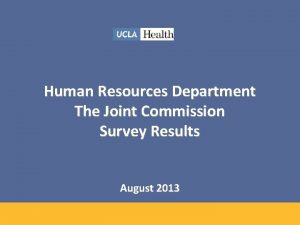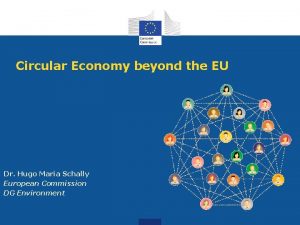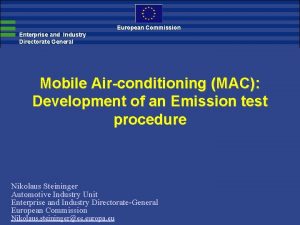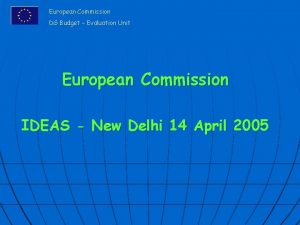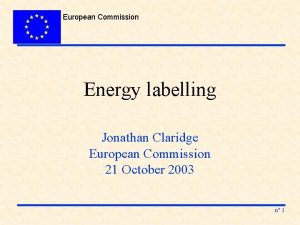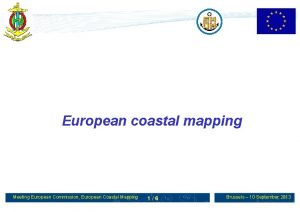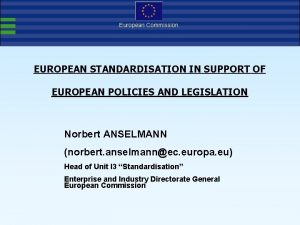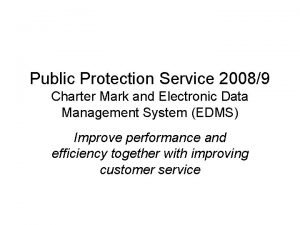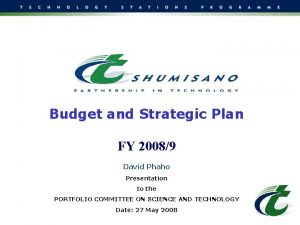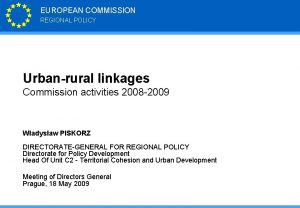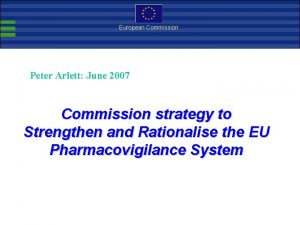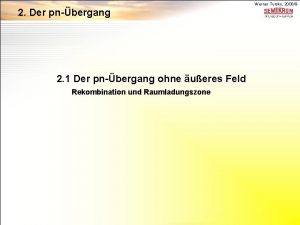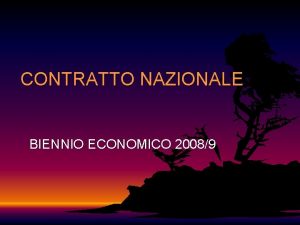Results of 20089 European Commission study Challenges and
















- Slides: 16

Results of 2008/9 European Commission study Challenges and opportunities for the future Prepared for: IRU 1 March 2012 Prepared by: Steer Davies Gleave 28 -32 Upper Ground London, SE 1 9 PD +44 (0)20 7919 8500 www. steerdaviesgleave. com The European Coach Market 1

Passenger Transport by Coach in Europe Ι The European Commission required a thorough review and analysis focussing on passenger transport by coach across Europe Ι This consisted of ■ Collection and analysis of coach sector data, including for cabotage services ■ Analysis of coach accident data ■ Analysis of the role of terminal infrastructure ■ Case study of the 12 -day rule on driver rest days Ι Steer Davies Gleave is an independent consultancy working worldwide across the transport sector Ι We carried out this study in 2008/9 with a team based in our London, Bologna and Madrid offices, supported by the Vehicle Safety Research Centre in the UK, and by sub-consultants in central Europe The European Coach Market 2

Contents Ι Context – legislation Ι Statistical summary Ι Issues: ■ Cabotage ■ Access to terminals Ι Opportunities The European Coach Market

Context – European legislation Ι Less European legislation applying to the bus or coach sectors than rail or air Ι Distinction between domestic and international regulation, international occasional market liberalised in the EU and regular international liberalised subject to national authorisation Ι Requirements on international carriage of passengers within the EU are defined in EC Regulation 1093/2009 Ι Regulation 561/2006 also sets out rules on driving times, breaks and rest periods Ι Regulation 181/2011 now defines passenger rights including ■ if services delayed or cancelled ■ passengers with reduced mobility (PRMs) The European Coach Market 4

Context - Market organisation Ι Significant variation in regulatory arrangements in different States Ι Study focussed on 8 States with different market structures Member State Regulated – restricted Germany Greece Regulated – concessions Deregulated Italy partly Poland partly Romania Spain Sweden UK The European Coach Market 5

Statistics - Introduction Ι Coach and bus are grouped together in most national statistics ■ No consistent definition of coach services ■ Definition used determined by the approach taken by each Member State ■ Where a particular approach has a big impact on the statistics we have noted this Ι For States where data is not readily available, extrapolated based on data from other Member States Ι Some factors affect the statistics significantly, e. g. school transport: ■ UK, France, Spain, Sweden and Ireland all contract special regular services that significantly affect number of passenger journeys. ■ Some EU citizens take the majority of their lifetime coach journeys whilst at school The European Coach Market 6

Coach demand against GDP Ι Coach travel is higher in the lowest income States. Increased incomes over time in these States can lead to: ■ Greater car ownership ■ Greater ability to afford to fly ■ Possible higher investment in competing rail services/infrastructure Ι However, coach travel is growing, albeit slower than GDP, in some western European States (France, UK, Spain) Ι This suggests that an increasing propensity to travel by all modes may increase the volume of coach travel, but probably not market share The European Coach Market 7

Coach market share against other modes of transport Ι Turkey and Bulgaria - high levels of bus and coach travel reflect low levels of car use Ι Germany and France, high rail share impacts on coach. The reverse is true in Greece Ι France – coach is higher than in reality as some bus classified as coach The European Coach Market 8

Proportion of coach journeys that are international Ι In most member states, the vast majority of coach journeys are domestic Ι The main exceptions are Austria and Germany, which both have large markets for outbound international coach tours, and have very little domestic regular markets The European Coach Market 9

Fares Ι Coach fares are generally lower (sometimes significantly so) than rail Member State Coach fares relative to rail Sweden, UK and Germany* Significantly lower (by ~50%) than rail Romania Lower than rail Greece, Italy and Poland Similar to rail Spain -Significantly lower than High Speed rail where this exists -Similar to rail fares on other routes * where regular services permitted The European Coach Market 10

Summary of estimates Total EU Passenger-kilometres (millions) Vehicle-kilometres (millions) Passenger journeys (millions) Fleet size Employees (bus & coach) Annual turnover (€ millions) The European Coach Market All States 262, 983 540, 512 10, 134 19, 899 6, 621 7, 584 248, 897 445, 715 1, 546, 955 2, 255, 445 15, 425 23, 560 11

Issues: Cabotage Ι Cabotage is defined as the operation of services within a Member State without having a registered office in that State Ι In 2008/9, in the majority of the case study countries, the level of cabotage services was very low and does not have a significant impact on the transport market Ι Regulation 1093/2009 expands the scope of cabotage operations permitted ■ if part of a regular international service, cabotage no longer has to be ‘temporary’ ■ removes the right of States to apply safeguard measures The European Coach Market 12

Issues: Access to terminals Ι Good terminal infrastructure can facilitate the development of the market by providing services such as: ■ Quality of customer service and facilities for passengers ■ Efficient scheduling of departure slots Ι Access to terminals not relevant if market access itself is restricted (eg. Germany, Greece) Ι In some other States terminal access may be a problem: ■ Poland: PPKS (State) companies own and operate services at Warsaw and other terminals ■ Spain: Access guaranteed for domestic, but Madrid terminal operator fined € 450 k for anti-competitive abuse on international Ι Integrated ticket sales desk may help reduce costs (if neutral) The European Coach Market

Opportunities – Liberalisation? Ι Study did not recommend particular market or regulatory structures Ι Liberalisation of regular services has a range of potential benefits: ■ more services ■ more competition ■ greater cost efficiency ■ lower fares Ι Some potential disadvantages: ■ reduced potential for transport integration ■ reduced co-ordination of services Ι No equivalent disadvantages to liberalisation of occasional services Ι Clarifying the meaning of “temporary” cabotage in the existing legislation could reduce the scope for Member States adopting their own, overly restrictive, interpretations The European Coach Market 14

Opportunities – Help governments reduce subsidy? Ι Regular coach services often do not need any subsidy despite offering lower fares than rail Ι Some EU governments have announced cuts to rail services due to lack of funds (Greece, Portugal) Ι Could coach be an alternative for medium/long distance routes? Ι Likely to be particularly attractive where: ■ Lower volume services (rail needs high volume to be cost-efficient) ■ Poor rail infrastructure ■ Good road infrastructure ■ Integrated into other transport systems The European Coach Market

Thank you The European Coach Market 16
 Graduated commission
Graduated commission Joint commission survey results
Joint commission survey results Traineeship office european commission
Traineeship office european commission Etrustex
Etrustex European commission
European commission Brendan devlin european commission
Brendan devlin european commission Adam romanowski european commission
Adam romanowski european commission Anic tschumi
Anic tschumi Inmaculada placencia porrero european commission
Inmaculada placencia porrero european commission Eu taxonomy
Eu taxonomy European commission
European commission Dr hugo maria
Dr hugo maria European commission
European commission Inmaculada placencia porrero european commission
Inmaculada placencia porrero european commission Cost benefit analysis european commission
Cost benefit analysis european commission European commission
European commission European commission
European commission

